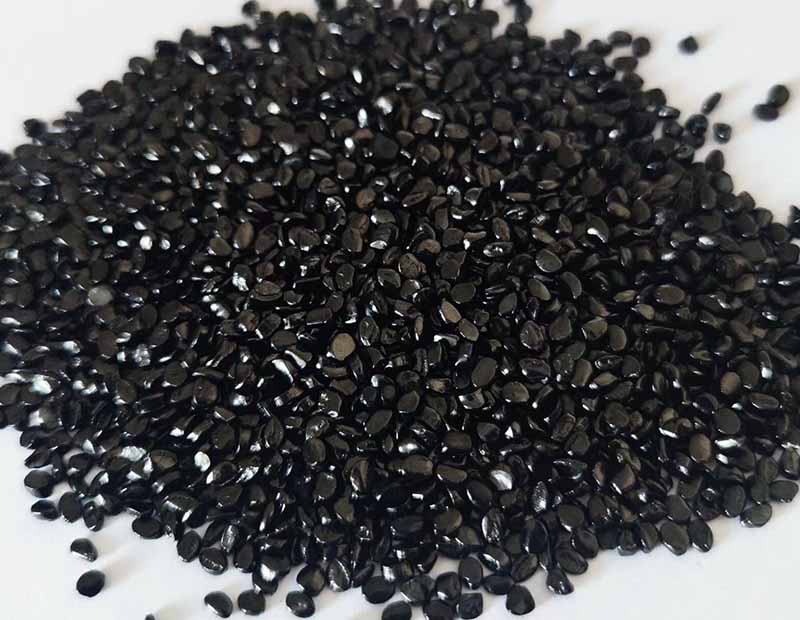1. Definition and Composition
High Temperature Black Masterbatch is a concentrated mixture of carbon black pigments and carrier resins specifically formulated to withstand extreme processing temperatures while maintaining excellent color stability. The typical composition includes 40-60% carbon black content dispersed in high-performance Polymer carriers such as polypropylene (PP), polyethylene (PE), or Engineering Plastics like PA6, PA66, or PPS. The formulation often includes thermal stabilizers that allow the masterbatch to maintain stability at continuous operating temperatures up to 300-350°C and short-term exposure up to 400°C.
The masterbatch achieves its thermal stability through specially selected carbon black grades with particle sizes typically ranging from 15-25 nm for optimal dispersion and heat resistance, combined with carrier resins having high melt flow indexes (MFI) between 5-20 g/10 min (230°C/2.16 kg) to ensure good processability.

2. Key Characteristics with Technical Data
Thermal Stability: Maintains color stability at continuous temperatures of 280-320°C (depending on carrier resin) with less than ΔE<3 color shift after 1000 hours of heat aging at 250°C.
Dispersion Quality: Achieves a dispersion quality rating of ≤1 (ISO 18553 method) with filter pressure values below 20 bar·cm²/g at 1% addition rate.
Light Fastness: Excellent UV resistance with 8+ rating (ISO 105-B02) and less than 10% reflectance at 550 nm wavelength for deep black coloration.
Mechanical Properties: When added at typical dosage of 2-4%, causes less than 5% reduction in tensile strength and impact properties of host polymers.
Electrical Conductivity: Volume resistivity can be tailored from 10^3 to 10^12 Ω·cm depending on carbon black grade selection.
3. Application Scenarios
High Temperature Black Masterbatch finds extensive use in demanding applications where both aesthetic requirements and thermal performance are critical:
Automotive Under-the-Hood Components: Used in engine covers, air intake systems, and cooling system components that experience continuous temperatures of 150-220°C and peak temperatures up to 250°C.
Electrical Connectors and Housings: For components requiring UL94 V-0 flammability rating and long-term heat resistance at 120-180°C service temperatures.
Industrial PiPES and Fittings: In chemical processing systems where pipes must withstand both high temperatures (up to 200°C) and aggressive media while maintaining black color integrity.
Consumer Appliances: For oven components, coffee machine parts, and other heat-contact surfaces that regularly experience 180-230°C during operation.
LED Lighting Components: In reflector housings and heat sinks where temperatures reach 150-200°C while requiring deep black appearance with >95% light absorption.
4. Processing Guidelines
Proper processing of High Temperature Black Masterbatch requires attention to several parameters:
Drying: Most grades require pre-drying at 80-100°C for 3-4 hours to achieve moisture content below 0.02%.
Processing Temperatures: Optimal melt temperatures range from 240-320°C depending on the carrier system, with barrel zone temperatures typically set 10-20°C higher than for natural polymer processing.
Screw Design: Recommend screws with L/D ratio ≥25:1 and mixing elements to ensure proper dispersion without excessive shear heating.
Injection Molding: Back pressure should be maintained at 50-100 bar for optimal dispersion, with injection speeds adjusted to prevent jetting.
5. Storage and Maintenance
To maintain the performance characteristics of High Temperature Black Masterbatch over time:
Storage Conditions: Store in original packaging at 15-25°C and <50% relative humidity, away from direct sunlight. Shelf life is typically 12-18 months under these conditions.
Material Handling: Use closed conveying systems to prevent moisture absorption, which should not exceed 0.05% before processing.
Machine Cleaning: When changing colors or materials, purge with natural polymer at processing temperature for 5-10 minutes, followed by a purging compound if necessary.
Regrind Usage: Can typically tolerate up to 20-30% regrind content without significant property degradation, provided the regrind is clean and properly dried.
For long-term storage exceeding 6 months, it's recommended to test the material for melt flow rate (MFR) and color strength before use, as some thermal stabilizers may degrade over time, particularly in humid environments.






